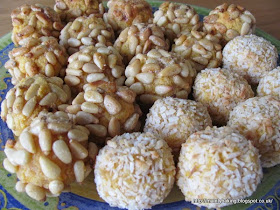 The word 'panellet' means 'little bread' in Catalan Spanish, although these little cookies are more often described as a type of marzipan. They are eaten in the Catalan area of Spain (around Barcelona) to celebrate All Saints' Day (1st November). I made them for the Formula 1 Foods challenge, at Caroline Makes, to celebrate the Spanish F1 Grand Prix taking place in Barcelona this weekend
The word 'panellet' means 'little bread' in Catalan Spanish, although these little cookies are more often described as a type of marzipan. They are eaten in the Catalan area of Spain (around Barcelona) to celebrate All Saints' Day (1st November). I made them for the Formula 1 Foods challenge, at Caroline Makes, to celebrate the Spanish F1 Grand Prix taking place in Barcelona this weekend
There seem to be many different ways of making panellets, some more complicated than others and although they are traditionally rolled in pine nuts, modern cooks often use cocoa, coconut, or slices of glace fruit to decorate them too. Whether or not to add mashed potato or sweet potato is also an issue; it's said to make the cookies moister but my guess it was originally used to act as a cheap 'padding' for the more expensive sugar and almonds.
The original recipe I found, in a book on Spanish cooking in the local library, made flat biscuits with a few pine nuts or pistachios sprinkled on top, but it didn't take much online research to show that panellets were usually rolled into balls, logs or crescents. After reading many recipes I decided to go with this one, because it worked with the small quantities that I wanted to use, was simple to do (it didn't use boiling sugar syrup, for instance) and had lots of helpful illustrations. Despite that, I think I made my cookies a little larger than they should have been.
I had to adapt the recipe a little, of course. Firstly, I added the zest of a lemon, as many recipes seemed to do this and I had bought a lemon before deciding on the final recipe. The dough was quite wet before adding any egg, so I only added the yolk. I used the remaining lightly beaten egg white to brush the tops of the pine nut covered cookies (rather than use another egg yolk), and because the cookies were so damp, they needed 20 minutes cooking at 180C to get a light golden colour. I didn't add the grilling stage as I was happy with the colour after baking. I ran out of pine nuts after 14 cookies, so the last few were rolled in desiccated coconut.
 The colour inside the panellets was quite vivid due to the bright orange of the sweet potato, and the cookies were very moist and soft in texture. The lemon gave an extra lift to the overall flavour of sweet marzipan.
The colour inside the panellets was quite vivid due to the bright orange of the sweet potato, and the cookies were very moist and soft in texture. The lemon gave an extra lift to the overall flavour of sweet marzipan.
These were more like balls of soft marzipan than cookies, and more suitable as after-dinner sweetmeats than cookies to have with a mid-morning cuppa! When eaten as part of the All Saints celebrations they are often served with sweet white wine. Sweet potatoes and chestnuts are also traditionally eaten during the celebrations.


they look so pretty and so expertly made. I've never heard of them but if they taste of marzipan then I want them. NOW!
ReplyDeleteThey both look good Suelle. Haven't heard of them either, but anything with marzipan is a winner with me!
ReplyDeleteI've never heard of these before but I like the way you can add different ingredients and decorations as you like. These look like very tasty little morsels - thanks for sharing with Formula 1 Foods!
ReplyDeleteInteresting. They look similar to certain Sicilian pasticcini di mandorle - "little almond pastries".
ReplyDelete